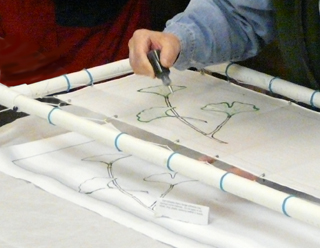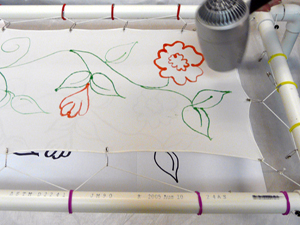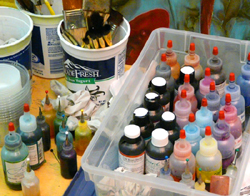workshop ideas
preparing for your silk-painting workshop
painting silk in the serti method using non-toxic water-based dyes -with artist Steve Scheibe
Supplies
Silk and painting supplies are all provided. A few items you may wish to bring are:
- a design/pattern for your final silk (see info below)
- color samples if you have specific colors in mind
- a camera
- lunch and/or snacks
- wear painting clothes or black in case you spill dye. Dyes bond to silk and wool most, will stain other natural fibers, and don't adhere well to synthetics.
create a pattern
Seven sheets of 8 1/2 x 11 (normal letter-size) paper taped together (on the long/11 inch edges) make a long template for an 11 x 60 inch scarf. Note that the actual silk scarf has rolled hem edges making it about a little smaller each way.
Create your design in pencil. Just draw the outlines of shapes. These lines will be your gutta/resist lines—barriers to the silk colors. When you are happy with your design, darken it (for visibility for tracing) with permanent dark color or black.
Sharpies work great.

Design—Use any shapes to create your design, considering that larger areas of color look most striking in dyes on silk. The dyes like to migrate within larger areas to create beautiful flowing patterns. Consider positive space (objects) and negative space (background). View your design from different angles/directions, making sure that secondary forms are all pleasing and intentional.
 Shapes— Fist-sized shapes and larger work especially well, but some can be smaller of course. Consider drawing freehand, or use photographs, photocopies, magazines, web or computer images, fabric designs, coloring books, wallpaper, any found objects, or natural shapes like leaves. Bring leaves or objects with you to the workshop if needed.
Shapes— Fist-sized shapes and larger work especially well, but some can be smaller of course. Consider drawing freehand, or use photographs, photocopies, magazines, web or computer images, fabric designs, coloring books, wallpaper, any found objects, or natural shapes like leaves. Bring leaves or objects with you to the workshop if needed.
Direction— When creating your design, consider if it will be worn, quilted, or hung like a banner. Which direction does it hang? If worn, which parts will be most visible?
 Colors—Maybe try a combination of colors from a reference photo, a favorite pillow, or even samples of paint, upholstery, quilting or clothing fabric you like. Often a leaf or a scene in nature will have many colors within it that work together harmoniously. It is sometimes helpful to begin with a foundation of three colors.
Colors—Maybe try a combination of colors from a reference photo, a favorite pillow, or even samples of paint, upholstery, quilting or clothing fabric you like. Often a leaf or a scene in nature will have many colors within it that work together harmoniously. It is sometimes helpful to begin with a foundation of three colors.
Pick out a light, a medium and a dark color.
A great website for colors is www.colourlovers.com
During the workshop, artist Steve Scheibe will help you mix colors and try to closely match your selected colors. Many pre-mixed colors are also available to add warmth and depth to your mixed colors. Be ready to experiment with the dyes to see what different colors do together.
HAVE FUN! Remember that the simplest of designs look fabulous in dye on silk.
